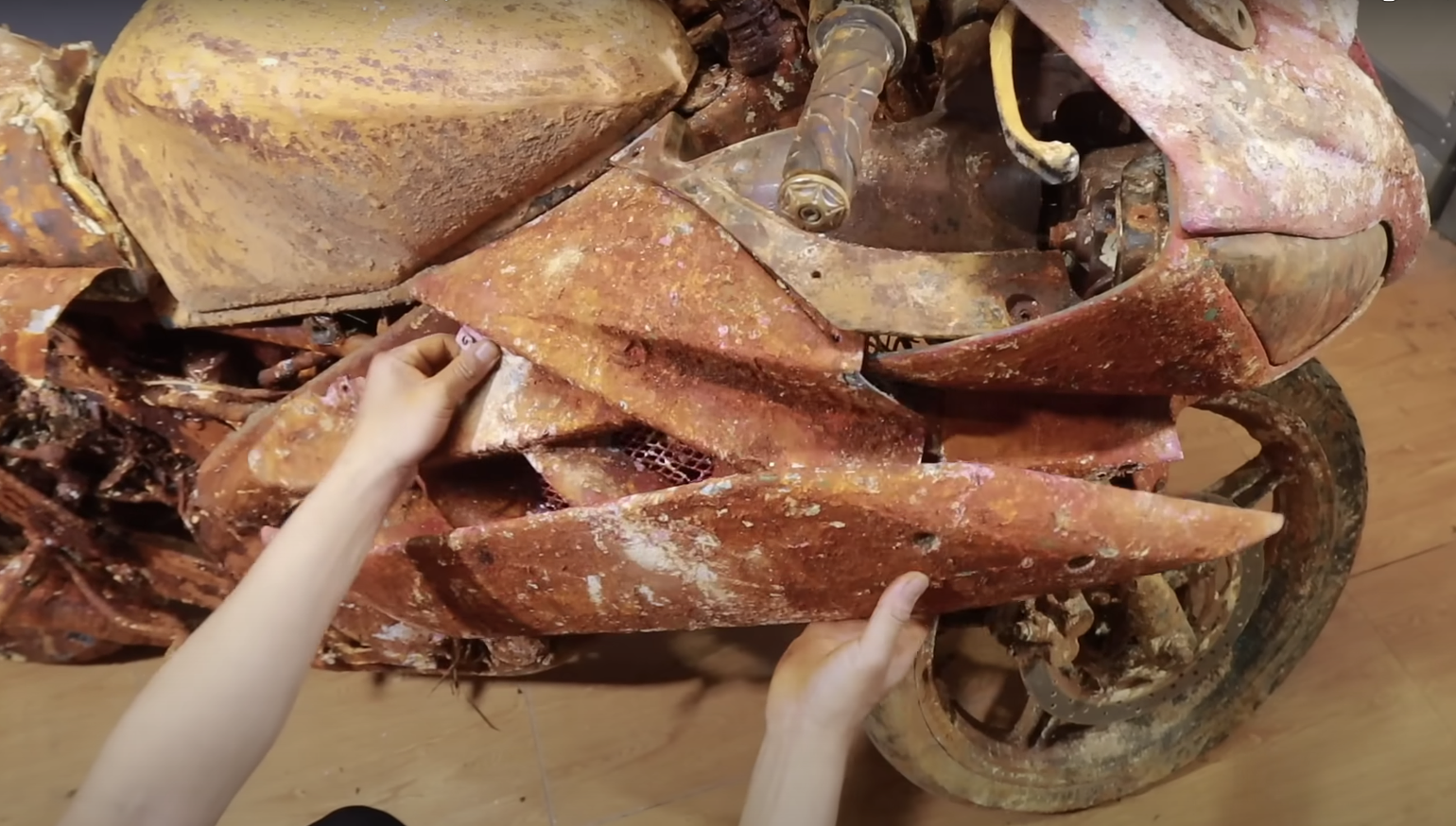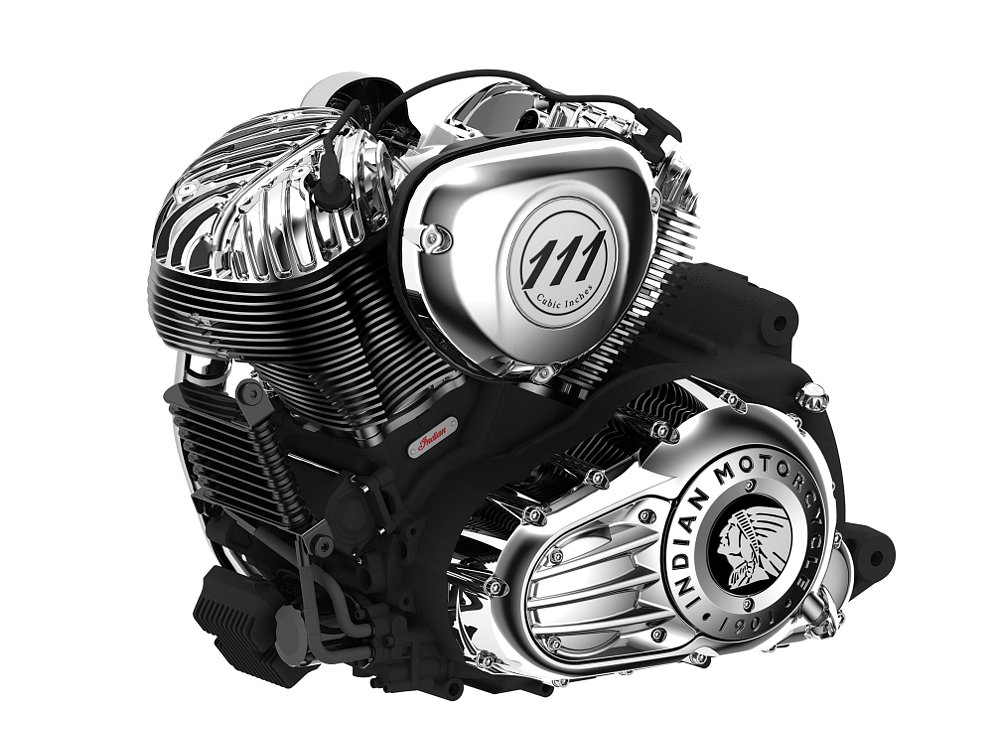A motorcycle restorer stumbles across filthy two-wheeler in the weeds. He drags it out for a closer look. The bike is covered in rust and thick mud. It looks like it has been abandoned for decades, but on closer inspection, the motorcycle isn’t more than a few years old. Hey, it still has the keys in it. Finders, keepers!
The happy new owner drags it home, where he does not wash his find. Instead, he starts pulling the bike apart right away. Side covers, fork, fenders, wheels, swingarm… Almost every nut and bolt comes off. The engine is disassembled, and it looks to be in pretty nice shape. Sweet! After some work with abrasives and rattle cans, the removed components are ready for reinstallation. The final result looks and runs like a brand new motorcycle.
Considering the machine’s condition when it was found, and the basic equipment used to fix it up, the restoration is incredible. You could even say it’s too good to be true. Stranger still, this exact storyline can be found in countless videos online. These uploads sometimes garner millions of views, with hundreds of comments applauding the work. Here's a video breakdown of one suspicious restoration:
A healthy dose of skepticism and even the slightest motorcycle restoration experience will quickly poke holes in these rescue-and-rebuild stories. Here’s what’s likely going on behind the scenes.
How to fake a motorcycle restoration video
- Purchase an inexpensive motorcycle or minibike to prepare for the video.
- The motorcycle is recorded running, riding, and looking neat as a pin. This footage is saved for later as the “final result” of the work. Sometimes it will be repainted before this step.
- Parts are removed off-camera and then reinstalled while recording. This becomes the “final assembly” part of the video, right before the final result shots, because everything still looks nice at this stage.
- The reassembled bike is made to look as bad as possible. Bring on the mud! Paint may be ground away to induce flash rust, or rust-colored paint can be sprayed on. Components may be intentionally damaged for dramatic effect. Remember, the worse it looks, the more impressive the restoration will appear at the end.
- The bike is planted in a remote location to appear abandoned, creating the beginning of the video. Bonus points for any gestures of surprise.
- Pretend to discover the bike in the weeds, a ditch, a riverbank, whatever. (One video with 25 million views supposedly finds a minibike buried several feet underground with an excavator. Amazing!)
- The motorcycle is disassembled again for the camera. Parts appear to be refurbished. Proper disassembly procedures are largely ignored because nothing needs to be handled carefully anymore. Show the repainting process here if changing colors. This makes up the middle of the video.
- Footage from step two is inserted at the end of the video, and to the casual viewer, the abandoned motorcycle has been fully restored. In reality, the bike is either complete and badly painted/assembled, or just a pile of parts left over from Step Seven. No problem — it has served its purpose for the video.
- Ideally, ad revenue from lots of views covers the low initial purchase price of the motorcycle and the rest is profit. Rinse and repeat.
There are variations to this formula, but the basic idea is mixing up the timeline to tell a fabricated story. Clever, I'll admit. Turning a cheap bike into millions of views with a camera, some basic supplies, and the magic of editing must be a tempting way to rake in some cash. Financial software giant Intuit estimates that a YouTube video with a million views can bring in $2,000 to $3,000 for the creator. For reference, a brand new pit bike can be purchased online for $400 to $1,200, so the margins aren’t bad at all. Keep in mind that many of these videos seem to originate from South and Southeast Asia, so the actual vehicle purchase prices and ad payouts will vary in different parts of the world. However the math works out, this style of restoration video became a full-fledged trend over the last few years as dozens of copycat channels show off their fixed-up "finds." They're easy to spot once you understand their MO.
On closer inspection, there are plenty of dead giveaways that these restorations aren't as they seem. Plastic, aluminum, and even rubber develop "rust" somehow. Parts gain and lose physical damage or change colors without explanation. Engines run when assembled carelessly. Continuity errors and cheesy discoveries are so common that the worst offenders could be mistaken for satire.
Harmless or exploitative?
I don’t think anyone sheds a tear when a dime-a-dozen pocket rocket or pit bike is ruined for clicks. I went far down the rabbit hole while researching this article, and I never saw anyone try this stunt with a motorcycle that was valuable or historically significant. Does it really matter that this is a trend?
I’m sure YouTubers who actually restore motorcycles aren’t too thrilled with their shady competition. Common Tread has never had any love for fake stuff, either. Restoration channels in general are a popular segment of YouTube because people like to see skilled repairs. Fake restoration channels only give the illusion of a job well done. Even so, I still watched their videos knowing that they were frauds, so I guess they still get the clicks they wanted in the end.
People also love to see fraudsters exposed, too, which led to a whole subgenre of videos debunking fake restorations. These also generate millions of clicks. Round and round it goes.
This phenomenon isn't just limited to motorcycle restorations, unfortunately. You'll find the same style of fake content involving things like electronics, musical instruments, tools, and watches, plus responses from skeptics trying to discredit the original uploaders. Tragically, there was even a fake animal rescue channel that attracted a huge following until YouTube shut it down in 2019. This Gizmodo article explaining the situation is not for the faint of heart.
It's amusing to scrub through fake motorcycle restorations for a few laughs, but don't rely on them for any kind of mechanical advice. And don't forget to watch a few real restorations to support creators who aren't just destroying things.

 Membership
Membership





